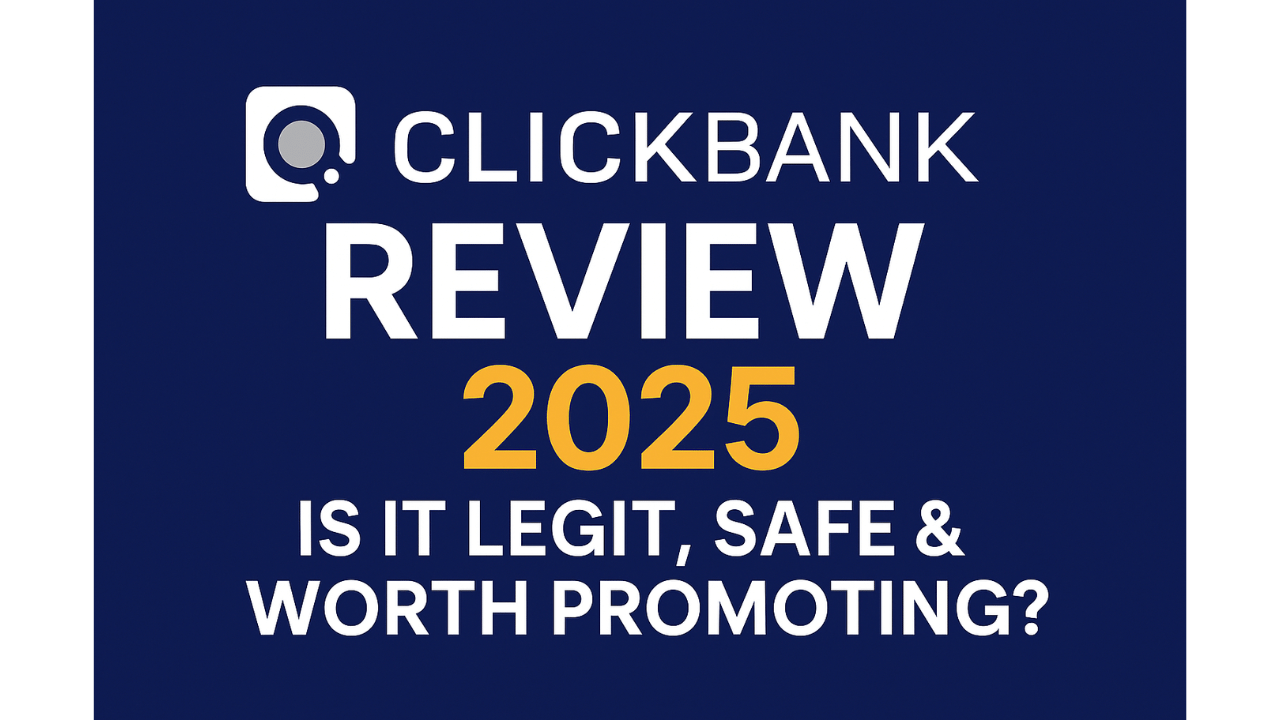If you’re wondering whether ClickBank is worth your time in 2025… you’re in the right place.
As someone who has spent years navigating the world of affiliate marketing, I’ve tested dozens of platforms, and ClickBank is always one that stirs both curiosity and skepticism.
Is it too outdated? Is ClickBank legit in today’s digital economy? Can it still generate online income for beginners and experienced marketers alike?
In this honest Clickbank review, I’ll break down everything you need to know before signing up or promoting a product from this well-known affiliate platform.
We’ll look at how it works for both affiliates and vendors, the quality of its digital products, how you get paid, real user reviews, and whether ClickBank is worth it in a landscape filled with new affiliate networks.
Whether you’re exploring ClickBank affiliate marketing for the first time or want to evaluate its tools and programs against competitors, this review will give you a clear, experience-backed perspective.
Table Of Contents
What is ClickBank and How It Works for Affiliates and Vendors?
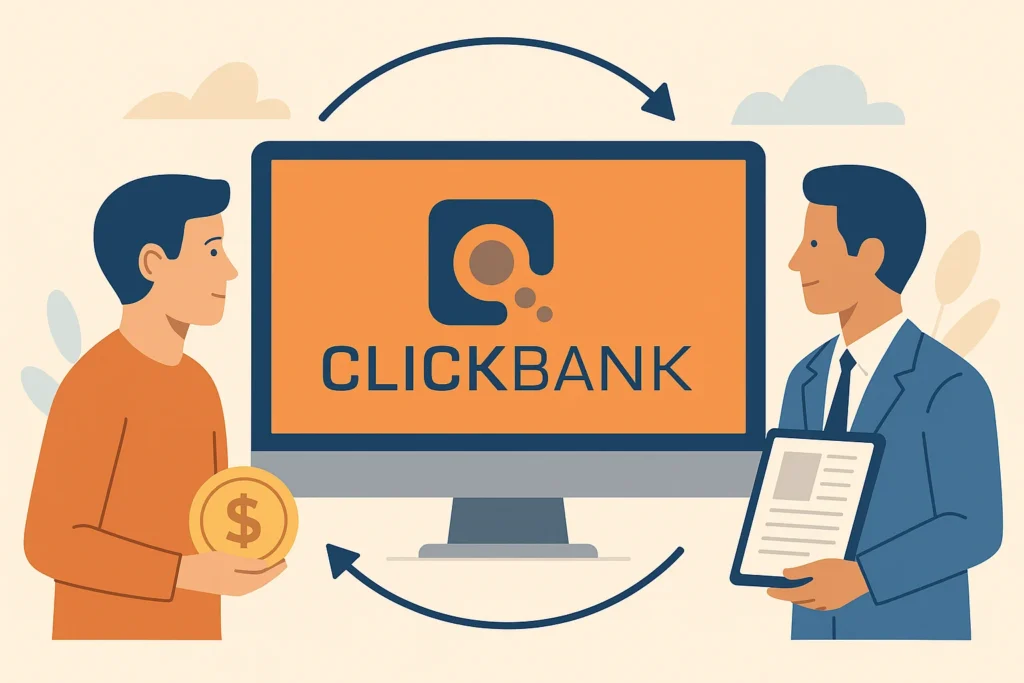
ClickBank is a global digital marketplace that connects content creators (vendors) with digital marketers (affiliates).
Launched in the late 90s, it has grown into one of the most recognized names in the affiliate marketing industry.
Its platform mainly deals with digital info products like eBooks, courses, training programs, software subscriptions, and niche tools.
Here’s how it works:
As a vendor, you create and upload a digital product to the ClickBank marketplace.
You also set the commission rate you’re willing to offer to affiliates who successfully sell your product. ClickBank handles the payment processing, refunds, and product delivery logistics.
As an affiliate marketer, you can browse thousands of offers, generate unique affiliate links, and promote the ones that match your audience.
When someone clicks your link and makes a purchase, you earn a percentage of the sale, often 50% or more, depending on the offer.
ClickBank stands out by lowering the barrier to entry.
There’s no application approval process for most products, making it easy for beginners to get started.
Additionally, affiliates don’t need a website to promote ClickBank products, though building a blog or using YouTube funnels can greatly enhance results.
The platform also includes a proprietary affiliate dashboard for performance tracking and a gravity score system to help you spot high-performing products.
This structure creates an accessible ecosystem for both sides: content creators get visibility, and marketers get products to promote with minimal friction.
Is ClickBank Legit or a Scam? Honest Breakdown
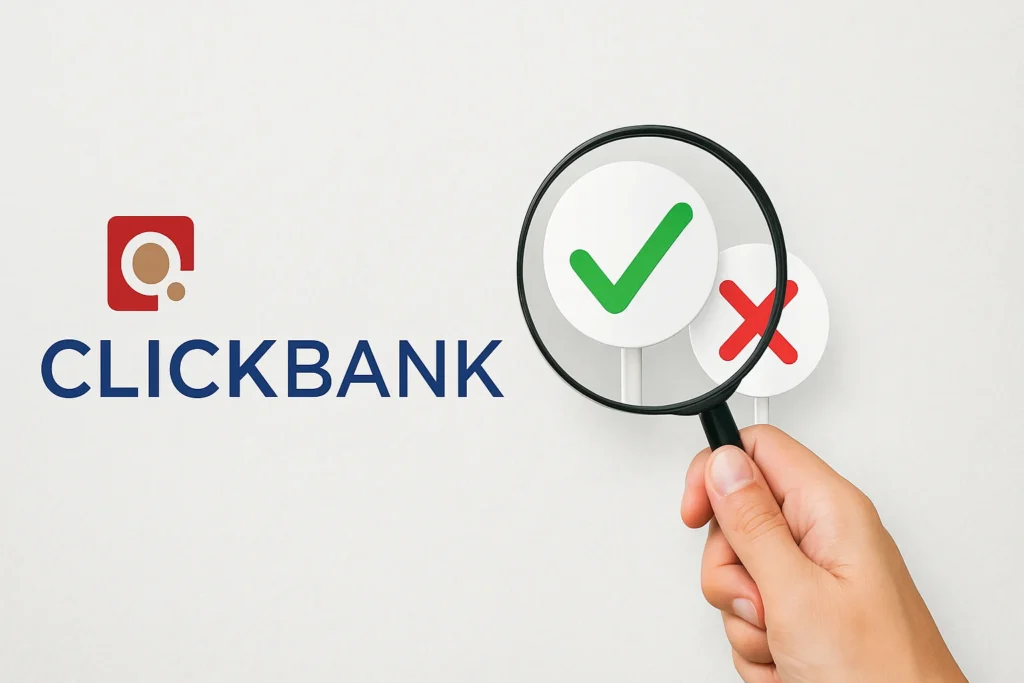
If you’ve typed “is ClickBank legit” into Google, you’re not alone.
The affiliate world is filled with platforms that promise high payouts and deliver little, so it’s natural to question the legitimacy of a program like ClickBank, especially one that has been around since the 1990s.
Let’s be clear: ClickBank is not a scam. It’s a legitimate and fully operational affiliate platform used by thousands of vendors and affiliates worldwide.
With over 20 years in business, millions of users, and billions in payouts, it has built a solid reputation, though, like any open marketplace, it has its pros and cons.
ClickBank’s Credibility Scorecard
ClickBank maintains a verified presence on Trustpilot, where real users provide public feedback.
While reviews vary, many affiliates highlight the platform’s easy onboarding, wide selection of digital products, and reliable payout system.
Its overall Trustpilot rating reflects a functioning, trustworthy marketplace, not a fly-by-night operation.
Moreover, ClickBank enforces a refund guarantee policy for most products.
This consumer-friendly approach helps maintain trust between buyers, affiliates, and vendors.
Refunds are processed efficiently through the platform, with a standard 60-day money-back window for most offers.
This safety net also discourages shady vendors from flooding the marketplace with low-value products.
What the Community Says?: Forums & Independent Reviews
Looking into forums like Reddit, WarriorForum, and digital marketing Facebook groups reveals a more nuanced perspective.
Experienced affiliates often say ClickBank is trusted when used correctly, but also caution that not every product is created equal.
A common criticism involves outdated sales pages or overhyped claims on certain offers, especially in the “make money online” niche.
ClickBank is also listed and reviewed on Gartner, under affiliate marketing platforms, where professionals highlight its ease of use, lack of entry barriers, and flexible commission models.
However, some note that the platform could improve vendor screening to ensure higher product quality across categories.
So, Is ClickBank Real or a Risky Gamble?
The answer depends on how you use it. ClickBank is fundamental and well-established.
Thousands of marketers trust it because it pays on time, provides performance analytics, and offers broad product diversity.
But like any affiliate platform, it’s your responsibility to vet the offers you promote.
Choose high-gravity products, review refund rates, and always test the sales funnel before sending traffic.
How to Sign Up for ClickBank ?

Getting started with ClickBank is surprisingly simple, which is one reason it remains a popular choice for beginners entering the affiliate marketing world.
Whether you’re signing up as an affiliate or a vendor, the registration process is user-friendly and designed to get you earning quickly, without the red tape many other platforms require.
Step-by-Step Sign-Up Process for Affiliates and Vendors
To begin, visit the official ClickBank Sign-Up page and choose whether you’re joining as an affiliate (to promote products) or a vendor (to list and sell digital products).
The system allows you to hold both roles under a single account, but each has its dashboard and tools.
You’ll be asked to provide basic information, including your name, country, email, phone number, and a secure password.
For vendors, additional fields include your business type, tax details, and a product description.
Once submitted, you’ll gain access to the Affiliate Dashboard, where you can browse the marketplace, generate affiliate links, track your performance, and start promoting offers immediately.
If you’re a vendor, you’ll be directed to the Vendor Account section, which includes tools for uploading your product, setting commission structures, and managing affiliate relationships.
Countries Accepted and Verification Requirements
ClickBank accepts users from a broad range of countries across North America, Europe, Asia, Africa, and beyond.
However, there are a few restricted countries where ClickBank services are limited or unavailable.
It’s essential to check the current list on their site before signing up.
KYC (Know Your Customer) verification is minimal compared to other platforms.
While you may be asked to verify your identity when setting up payment methods, ClickBank does not typically require extensive documentation to get started.
This ease of access is ideal for freelancers, bloggers, and digital marketers who want to avoid bureaucratic delays.
Are There Any Fees to Use ClickBank?
ClickBank does not charge any upfront or monthly fees to affiliates.
You can create an account, access the platform, and start earning without paying a dime.
That makes it attractive for those exploring online income opportunities without financial risk.
However, vendors will need to pay a one-time activation fee when listing a product:
- $49.95 for the first product
- $29.95 for each additional product
There’s also a small $2.50 payment processing fee per sale, which is deducted from vendor earnings.
Additionally, inactive accounts (with no earnings for 90+ days) may incur a small maintenance fee, but this is avoidable by staying active or cashing out regularly.
For those who want to level up their knowledge, ClickBank University offers paid training resources.
It’s entirely optional but helpful for beginners looking to shorten the learning curve.
How to Make Money with ClickBank ?

Understanding how to earn money through ClickBank is essential if you’re planning to turn affiliate marketing into a reliable stream of online income.
The platform’s flexible commission structures, wide range of product types, and performance tracking make it suitable for both beginners and experienced marketers aiming to maximize their ClickBank ROI.
At its core, ClickBank operates on two primary models: CPS (Cost Per Sale) and CPA (Cost Per Action).
While most products follow the CPS structure, some newer or exclusive offers may operate on a CPA basis, allowing affiliates to earn commissions even when users don’t make a direct purchase.
1. CPS vs CPA – What You Really Earn
In a CPS model, affiliates earn a percentage of each sale they refer.
For instance, if you’re promoting a digital course priced at $97 and the vendor offers a 60% commission, you earn around $58 per sale.
ClickBank products often offer commission rates between 50% 75%, significantly higher than most physical product affiliate programs.
On the other hand, some programs offer CPA-style commissions, where affiliates are paid when users take predefined actions like signing up for a free trial, downloading a lead magnet, or entering an email address.
These can be helpful for beginners who are still building trust with their audience or working with colder traffic sources.
Both models can generate income, but understanding the conversion journey is key.
CPS rewards high-quality traffic and persuasive content, while CPA is more suitable for lead-focused funnels and email opt-ins.
2. Recurring Commissions – Long-Term Earnings Made Easy
One of the most significant advantages of using ClickBank is access to products that offer recurring commissions.
These are typically subscription-based services like SaaS tools, membership sites, or coaching communities.
Once a user subscribes via your affiliate link, you continue to earn a commission every month as long as they remain an active customer.
For example, if you refer someone to a membership program that pays $30/month with a 50% recurring payout, you earn $15 every month, passively.
Over time, this adds up and creates compounding affiliate income with minimal ongoing effort.
If you’re serious about building consistent affiliate revenue, it’s smart to focus on these types of offers.
You can explore more options in our Best Recurring Affiliate Programs guide, which highlights ClickBank-friendly tools that offer long-term earning potential.
Can You Really Make Money with ClickBank?

The question “can you really make money with ClickBank?” often comes from people skeptical about affiliate platforms that promise fast profits.
The short answer is yes, you can—but only if you treat ClickBank like a business, not a shortcut.
ClickBank provides a framework, not a guaranteed paycheck.
It connects you to thousands of digital products, generous commission rates, and tools to track your efforts.
But ultimately, your success depends on how well you execute your affiliate promotions, build trust with your audience, and drive targeted traffic to offers.
Realistic Expectations: What Affiliates Actually Earn
Some affiliates earn thousands each month, while others make little to nothing.
Why the gap? It comes down to traffic sources, messaging, niche selection, and promotional methods.
New marketers with no list, no strategy, and no content often fail because they expect overnight results.
On the other hand, those who use SEO-optimized blogs, YouTube funnels, or email marketing systems tend to generate consistent affiliate earnings by focusing on value-first content and audience alignment.
ClickBank has been used to power six-figure blogs, niche sites, and influencer-driven campaigns.
There are public success stories of affiliates making $100–$500 per day by focusing on high-converting offers with solid sales pages and low refund rates.
But these results usually stem from months of building authority, testing, and refining the approach, not hacks or shortcuts.
Why Traffic Matters More Than the Platform Itself
ClickBank doesn’t provide the traffic you do. Whether your audience comes from search engines, social media, email lists, or video platforms, the way you direct attention toward offers is what determines success.
For instance, a well-targeted blog post reviewing a ClickBank health product can convert highly when matched with organic search intent.
Similarly, a how-to YouTube video linking to a ClickBank course can generate dozens of daily clicks, translating into regular commissions.
Even the best affiliate offers fail without the right audience.
That’s why traffic sources like Google, Pinterest, YouTube, and email newsletters play a bigger role in success than the affiliate network itself.
Finding Products to Promote on ClickBank – Gravity Score & Niches

One of the biggest advantages of ClickBank is its open marketplace where affiliates can browse, filter, and choose from thousands of digital products.
But with so many offers available, knowing how to identify high-converting products in the right niche is critical to your success.
Understanding the ClickBank Marketplace Structure
The ClickBank marketplace is organized by categories and subcategories, making it easy to find products aligned with your blog, YouTube channel, or email list.
Categories range from health and fitness, finance and investing, to self-help, relationships, and software.
Each product listing includes vital data such as commission percentage, average payout, refund rate, and a key performance indicator known as Gravity Score.
These metrics help you predict how well a product might convert, saving you time and effort during your campaign planning.
Whether you’re new to the platform or already testing offers, learning how to read and interpret marketplace data is a vital part of any successful ClickBank affiliate program review strategy.
What is Gravity Score and Why Does It Matter
The Product Gravity Score is one of the most critical metrics inside ClickBank. It reflects how many affiliates have made a sale with that product in the past 12 weeks.
A higher score means more affiliates are earning commissions from that product.
But a high gravity doesn’t always mean the product is right for you. For example:
- A score of 50 to 100 usually indicates a strong-performing product that is currently converting well.
- A gravity over 150 might suggest intense competition or market saturation.
- A gravity under 20 could mean poor conversions or a newer product that hasn’t gained traction yet.
Smart affiliates look for a balance: a moderately high gravity score paired with a decent commission rate and a clean, persuasive sales page.
Best Niches on ClickBank in 2025
When it comes to niche marketing, choosing the right vertical makes all the difference. Based on current trends and product performance, here are a few profitable niches in 2025:
- Health and Fitness: Weight loss, supplements, sleep optimization, and hormone balance products continue to dominate.
- Finance and Investing: Crypto training, stock market courses, and side hustle programs are highly searched.
- Self-Help and Personal Development: Mindset, manifestation, productivity, and life coaching remain evergreen.
- Online Business and Marketing: Affiliate tools, funnels, content creation, and AI marketing platforms are gaining momentum.
Each of these niches offers multiple high-converting offers with solid commission structures and recurring income potential.
The key is to align your niche with the interests of your audience and select products with trustworthy sales pages, low refund rates, and reasonable gravity scores.
How to Create and Track HopLinks Correctly
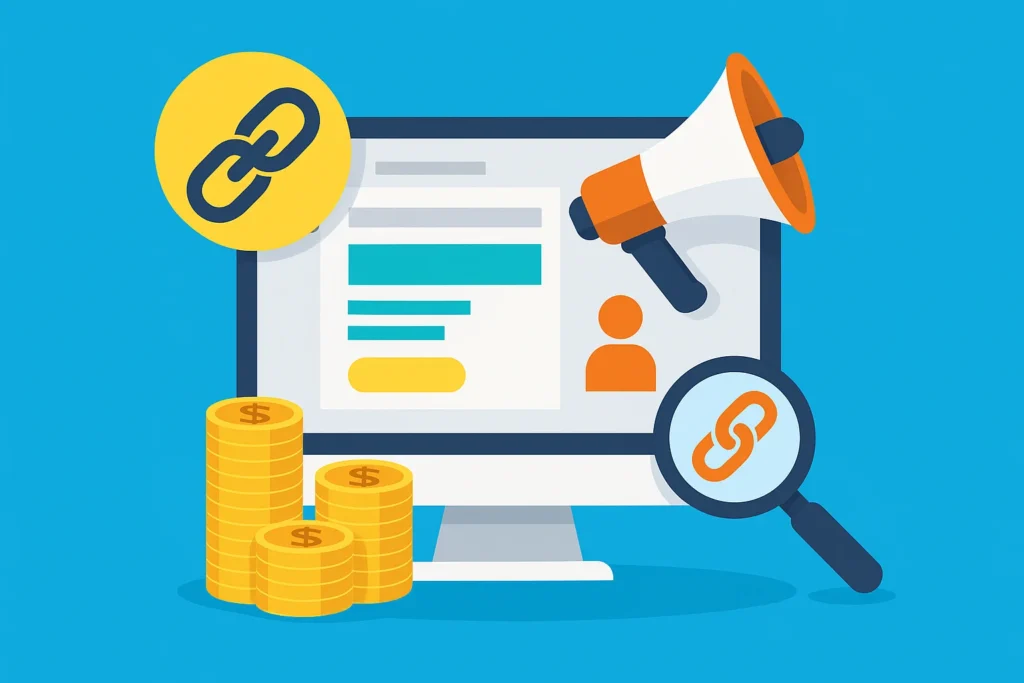
Once you’ve found a product to promote on ClickBank, the next step is generating your HopLink a unique affiliate link that tracks your referrals and ensures you get paid for each sale.
Getting this step right is crucial, especially if you’re serious about building a profitable affiliate marketing business.
1. How to Generate a HopLink? (Step-by-Step)
To create a HopLink:
- Log in to your ClickBank affiliate dashboard.
- Navigate to the Marketplace and find the product you want to promote.
- Click the “Promote” button beside the offer.
- Enter your account nickname and any optional tracking ID.
- Click “Generate HopLink.”
You’ll receive a long URL that contains your encrypted affiliate information. This is the link you’ll use in blog posts, emails, or on social media to drive traffic to the offer.
2. Tracking Parameters
ClickBank offers advanced tracking options using TID (Tracking ID) and VTID (Vendor Tracking ID).
These parameters help you understand exactly where your conversions are coming from.
- Use TID to track internal campaigns like blog posts, YouTube videos, or email subject lines.
- Vendors may also assign a VTID, which lets them monitor how each affiliate is performing. This often helps affiliates qualify for private offers or custom commission bumps.
For example, a TID like ?tid=blogreview can help you determine if a sale came from your ClickBank product review article.
Over time, these insights allow you to fine-tune your affiliate promotions and invest more in traffic sources that convert.
3. Shorten and Manage HopLinks with Pretty Links
While raw HopLinks work just fine, they can look long and unappealing, especially in emails or under YouTube videos.
Tools like Pretty Links let you shorten, brand, and track your HopLinks easily.
For instance, instead of sharing:
yourdomain.com/recommends/productname
This not only improves click-through rates but also adds a layer of trust for your audience.
Many successful ClickBank affiliate marketers use this tactic to keep their links clean and optimized for better engagement.
Key Features and Tools for Affiliates – Dashboard, PitchPlus & More
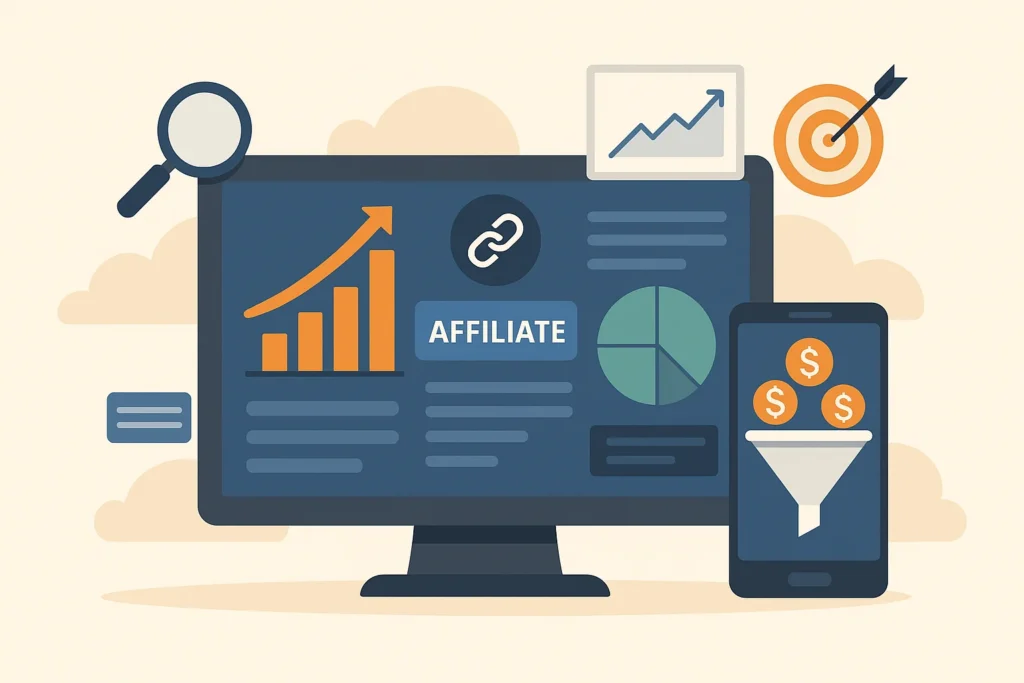
ClickBank is more than just a place to grab affiliate links and hope for conversions.
What sets it apart is the set of built-in tools designed to help marketers track performance, optimize promotions, and scale their results, whether you’re new to the platform or already running affiliate campaigns.
Understanding how these tools work can make a real difference in your conversion optimization strategy.
1. Affiliate Dashboard
Once you’ve created a free account, the Affiliate Dashboard becomes your primary workspace. It gives you access to real-time performance data, including:
- Gross revenue and net commissions
- Order count and refund rates
- Daily and historical earnings breakdown
What makes the helpful dashboard is how it ties every sale to your traffic and affiliate promotions through the TID system.
With proper tracking IDs, you can view which content, landing pages, or traffic sources are generating results, helping you scale what works and cut what doesn’t.
This is essential for long-term ClickBank affiliate marketing success and optimizing online income strategies.
2. ClickBank Insights
ClickBank Insights is another powerful tool that helps you understand affiliate trends and product data. It offers visibility into:
- Product popularity over time
- Conversion rates by niche
- Gravity score history
This is especially useful when you’re evaluating new offers or comparing competing products.
By leveraging this data, you can focus on promoting offers with better engagement and low refund rates, aligning with your audience’s interests and maximizing your ClickBank ROI.
3. Marketplace Filters
The ClickBank marketplace isn’t just a catalog of products—it’s an intelligent system with filters that allow you to sort offers by:
- Gravity score
- Commission %
- Recurring billing
- Category or niche
- Refund rate
These filters are vital for identifying high-converting offers within your niche.
For example, if you’re targeting fitness bloggers or YouTube viewers, you can quickly find health-related recurring products with 60%+ commissions and good gravity scores.
4. PitchPlus and Sales Funnel Tools
ClickBank’s PitchPlus feature allows vendors to offer upsells and downsells to buyers immediately after the initial purchase.
This is a significant opportunity for affiliates, as commissions often apply to the entire sales funnel, not just the first product sold.
For affiliates promoting offers with PitchPlus, this can significantly increase the average order value (AOV), making each referral far more valuable.
The platform also provides sales funnel previews, so you can understand the full monetization path before promoting a product.
5. JV Tools and Partner Promotions
Many vendors on ClickBank offer Joint Venture (JV) tools for affiliates. These include:
- Email swipe files
- Ad creatives
- Bonuses and custom landing pages
- Pre-written blog copy or video scripts
Using vendor-supplied materials saves time and ensures your promotions match the tone of the sales page.
This can increase trust, engagement, and ultimately, conversions.
ClickBank Payment System – Payouts, Thresholds & Refund Policy
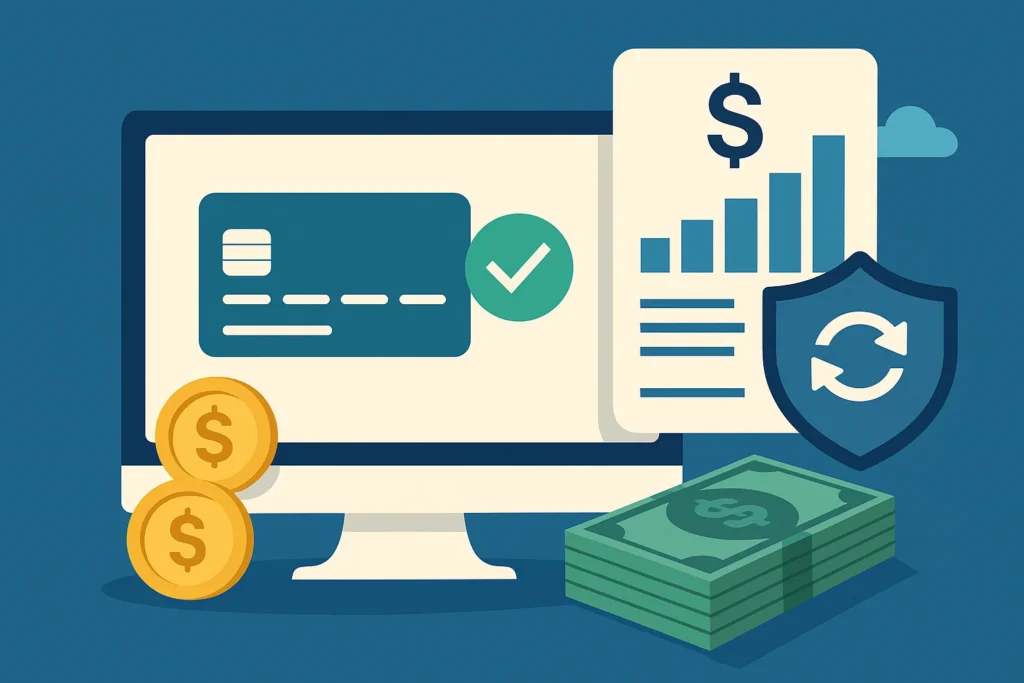
Understanding how ClickBank handles payment processing is essential before you start promoting offers.
Whether you’re aiming for a side income or full-time affiliate revenue, knowing when and how you get paid and what can affect your commissions will help you plan smarter and avoid surprises.
1. How and When You Get Paid
ClickBank offers flexible payout methods, giving affiliates options that work across most regions. You can choose from:
- Direct deposit to your bank account (available in many countries)
- Payoneer for global payouts
- Wire transfer for high-volume earners
- Paper checks (still available in select cases)
Payments are processed on a weekly or bi-weekly schedule, depending on your preferences and account history.
By default, most new accounts are set to receive weekly payouts every Wednesday.
To qualify for scheduled payments, you must first meet your minimum payout threshold.
2. Understanding the Payout Threshold
The payout threshold is the minimum amount you need to earn before ClickBank will send your payment. You can set this threshold yourself in your account settings, with options starting at $10.
However, most affiliates opt for $50 or more to reduce processing fees and bank transfer costs.3
For example, if your threshold is $100 and you only earn $85 this week, your payment will roll over to the next cycle until you meet the full amount.
Once your threshold is reached, ClickBank processes the payout automatically during the next cycle.
Keep in mind that your account must also pass customer distribution requirements, which means your commissions must come from multiple payment methods (e.g., different credit cards) before your first payout is released.
This helps prevent fraud and boosts the credibility of your account.
3. Refunds and Their Impact on Affiliate Earnings
ClickBank maintains a Refund Guarantee for most products, which ensures customers can request a full refund within 60 days if they’re unsatisfied.
While this policy helps build buyer trust, it does affect affiliate earnings when refund requests are processed.
If a customer refunds a product you referred, your commission is deducted from your upcoming payout.
High refund rates can reduce your overall revenue and skew your performance metrics, which is why it’s critical to promote high-converting offers with proven quality and positive customer feedback.
ClickBank offers real-time access to refund data in your affiliate dashboard, allowing you to monitor the refund rate per product.
When vetting offers, be sure to consider the gravity score alongside historical refund percentages.
This combination helps you prioritize offers that convert well and deliver long-term earnings.
ClickBank Spark & Accelerator: Are They Worth It?
If you’re just getting started with affiliate marketing and looking for structured guidance, you’ve probably come across ClickBank Spark and the ClickBank Accelerator program.
These training tools are designed to help new and intermediate marketers learn how to build sales funnels, pick profitable products, and create scalable campaigns within the ClickBank ecosystem.
But are they worth your investment?
Let’s take a closer look at what they offer and who they’re best suited for.
What Is ClickBank Spark?
ClickBank Spark is a beginner-friendly educational platform offered directly by ClickBank.
It functions as a self-paced learning environment with modules covering all the core fundamentals of affiliate marketing. Inside Spark, you’ll find:
- Step-by-step video tutorials
- Interactive workbooks and worksheets
- Product selection strategies
- Funnel-building frameworks
- Traffic generation methods
In addition to training, Spark also provides pre-built template assets you can use to launch your first campaigns.
These include landing page examples, offer analysis templates, and email swipe files tailored for ClickBank affiliate programs.
Spark is beneficial for those who are new to online courses and want a complete system that shows what to do and in what order without needing to patch together free content from multiple sources.
ClickBank Accelerator – Designed for Scaling Faster
The ClickBank Accelerator is a more advanced, premium-level coaching system for marketers who already understand the basics and want to move toward building an automated business model.
It includes access to:
- Weekly coaching calls with experienced ClickBank professionals
- Done-for-you sales funnel structures
- High-converting affiliate offer breakdowns
- Action-based checklists to move from setup to scaling.
Unlike Spark, which is more general-purpose, the Accelerator is tailored toward action-takers who want measurable results quickly and are ready to test and invest in paid traffic strategies.
This program walks you through funnel testing, copywriting tweaks, and product-to-audience alignment, helping reduce wasted effort and increase ClickBank ROI.
Who Should Use Spark or Accelerator?
If you’re brand new to affiliate marketing and looking for a proven path to your first sale, Spark offers everything you need to build a strong foundation.
It saves time, reduces guesswork, and provides structure that free tutorials rarely offer.
Suppose you already understand basic affiliate concepts and want to grow your results through advanced tactics like A/B testing, scaling offers, and building out multiple sales funnels.
In that case, the Accelerator can help shortcut the learning curve and increase your earning potential.
That said, neither program is required to succeed on ClickBank. You can use free tools, independent blogs, or your research to build campaigns.
But if you value hands-on guidance and prefer a step-by-step system, both Spark and Accelerator can accelerate your results.
ClickBank for Vendors – Selling Your Product on ClickBank

While most people know ClickBank as a platform for affiliates, it’s equally powerful for digital product creators.
Suppose you’ve built a course, an eBook, a software tool, or any other type of digital product.
In that case, ClickBank allows you to become a vendor and sell it through their affiliate marketplace, giving you exposure to thousands of affiliates looking for quality products to promote.
Let’s explore how the vendor side works and how to set your product up for success inside ClickBank.
1. Inside the Vendor Dashboard
Once you switch to or create a vendor account, you’ll gain access to the vendor dashboard, which is tailored to product sellers. This dashboard includes tools to:
- Upload and manage your digital product.
- Set commission percentages for affiliates.
- Create upsell paths using PitchPlus.
- Monitor refund rates, sales data, and affiliate performance.
- Set pricing tiers and product delivery options
Everything is centralized, making it easy to manage one or multiple products from a single backend.
The interface is straightforward, which is helpful if you’re transitioning from platforms like Teachable, Gumroad, or Podia.
2. How to List a Product and Set Commissions
To list your product, you’ll need to submit your product page for approval along with a working payment link, a thank-you/download page, and your terms of service.
Once approved, you can list your offer in a specific marketplace category and assign commission rules.
ClickBank allows you to offer up to 75% commission per sale to attract high-performing affiliates.
You can also offer recurring commissions if your product is subscription-based.
You control whether your product appears publicly in the ClickBank marketplace or is available only through private JV partnerships.
For maximum reach, most vendors opt for a public listing to leverage ClickBank’s affiliate base.
3. Getting Affiliates to Promote Your Product
Even with a live listing, your product won’t sell unless it appeals to affiliates. Here are a few tips to make your offer stand out:
- Write a compelling pitch title and description using conversion-focused copy.
- Offer generous commissions and low refund rates to build credibility.
- Use ClickBank’s Refund Guarantee window (usually 60 days) to reassure buyers.
- Provide a JV page with promotional materials, email swipes, and landing pages.
- Reach out to top affiliates directly with custom offers or bonuses.
Affiliates are more likely to promote products that already have momentum, so make sure your sales page is polished, your funnel is tested, and your affiliate resources are readily available.
By taking advantage of ClickBank’s vendor tools, you can build a passive income stream and benefit from an active affiliate network that scales your reach without needing an in-house sales team.
ClickBank vs Other Affiliate Networks – JVZoo, Digistore24, WarriorPlus
If you’re evaluating platforms to start or scale your affiliate marketing journey, it’s crucial to compare ClickBank with other well-known networks like JVZoo, Digistore24, and WarriorPlus.
Each platform has its strengths, product range, and affiliate tools, and choosing the right one depends on your niche, promotional style, and income goals.
In this affiliate network comparison, we’ll break down what sets these platforms apart and when ClickBank may be the better option.
1. JVZoo
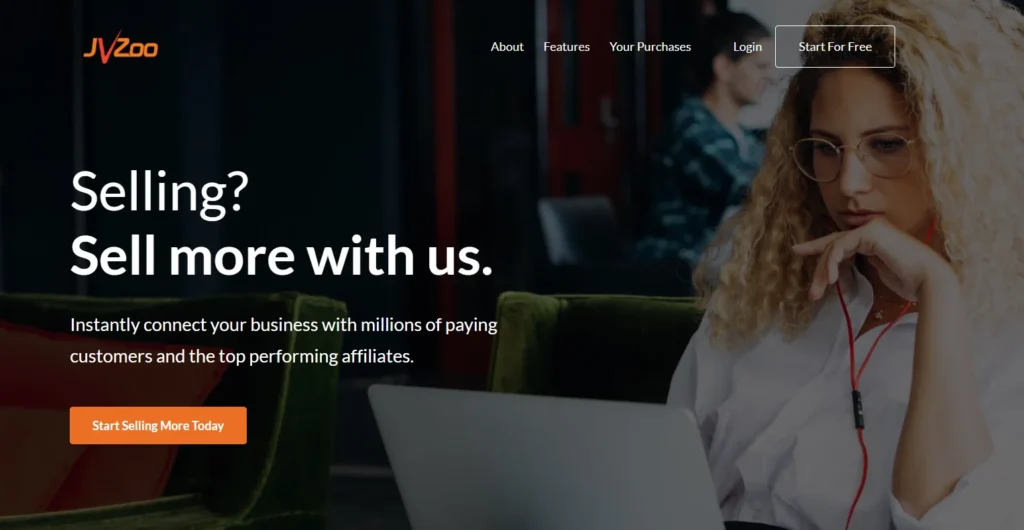
JVZoo is often compared to ClickBank due to its focus on digital products, especially in the internet marketing, software, and business tool niches.
It offers real-time affiliate approval, and products often include lifetime or tiered commissions.
Pros of JVZoo:
- Instant commissions through PayPal for qualified affiliates
- Strong focus on SaaS, software tools, and marketing templates
- Fast approval process for affiliates
Cons:
- Higher refund rates in the make-money-online niche
- Less product screening compared to ClickBank.
- Support responsiveness can vary by vendor.
Compared to ClickBank, JVZoo may appeal to affiliates promoting digital tools to marketers but lacks the marketplace-wide refund guarantee that ClickBank offers.
2. Digistore24
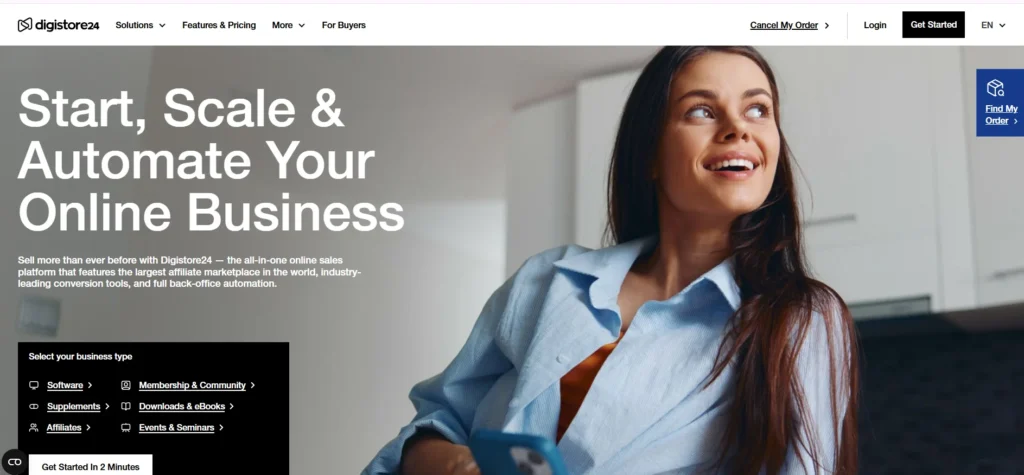
Digistore24 is a growing affiliate platform that also focuses on digital products and increasingly on physical products.
It combines ease of use with global reach and supports recurring commissions and robust tracking.
Pros of Digistore24:
- Clean, user-friendly interface
- Recurring commission offers across multiple verticals.
- Accepts affiliates from more countries than many competitors
Cons:
- Fewer products overall compared to ClickBank
- Less marketplace momentum in specific niches
Digistore24 is a strong alternative for affiliates looking for automated commission tracking and offers that span health, wealth, and education niches.
However, ClickBank still maintains a broader range of high-converting offers and a larger marketplace in most verticals.
3. WarriorPlus
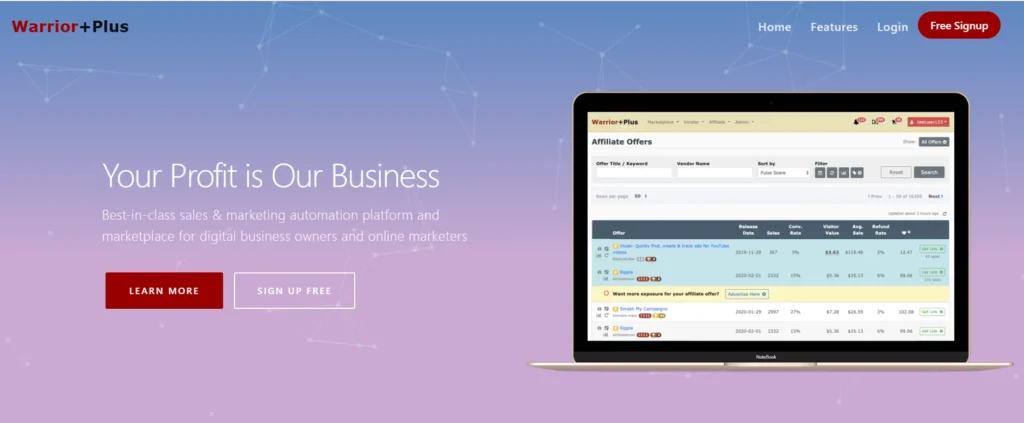
WarriorPlus is another platform often used in the marketing and biz-op niches. While it has a loyal user base, it’s known for promoting products with aggressive sales tactics and minimal product validation.
Pros of WarriorPlus:
- High-commission digital info products
- Active community of vendors and affiliates
- Strong in the IM (Internet Marketing) space
Cons:
- Product quality can be inconsistent
- Limited refund transparency
- Weak compliance and oversight
WarriorPlus may be helpful for short-term or tactical campaigns, but affiliates looking for long-term credibility and lower refund rates may prefer ClickBank’s marketplace structure and vendor screening process.
When Should You Choose ClickBank?
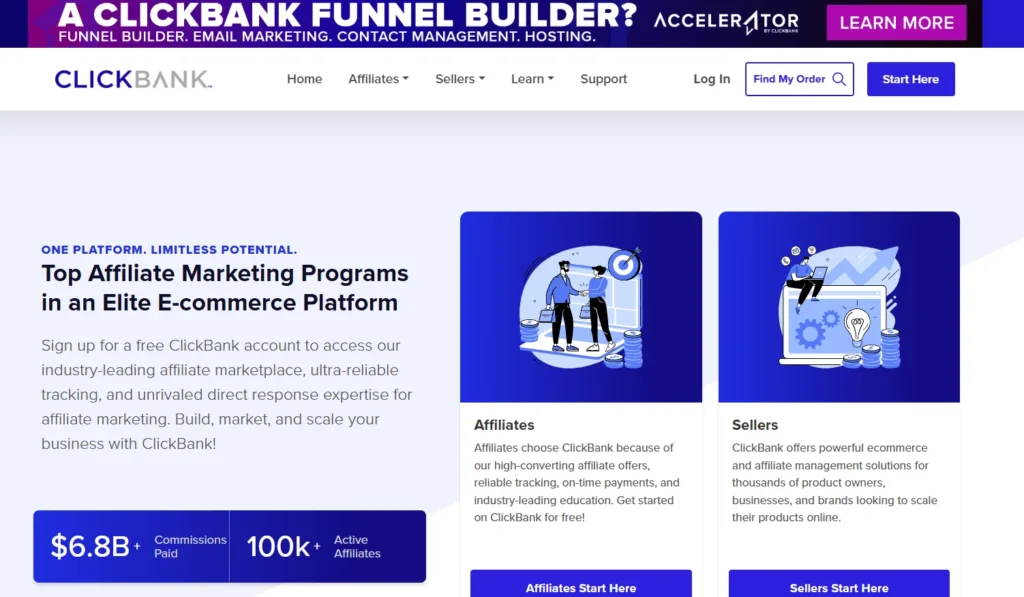
ClickBank stands out for a few key reasons:
- Refund Guarantee: Buyers have peace of mind, which increases trust and conversion.
- Marketplace Depth: Thousands of products across evergreen niches like health, wealth, and personal development.
- Trusted Brand: ClickBank has been around for over two decades and has paid out billions in affiliate commissions.
- No Approval Needed: You can promote most offers instantly, which helps new affiliates start earning quickly.
If your focus is on long-term affiliate success, with high-converting offers, transparent product data, and a user-first approach, ClickBank remains one of the most stable platforms in 2025.
How to Drive Traffic to ClickBank Offers (Free + Paid Methods)
Once you’ve chosen the right products and set up your affiliate links, the next critical step is traffic.
Without consistent visitors, even the most high-converting ClickBank offer won’t deliver results.
Whether you’re relying on free traffic sources or testing paid campaigns, your success depends on your ability to drive qualified traffic that matches your offer’s message.
Let’s explore the most effective traffic sources and how to align them with your ClickBank promotions.
1. Best Traffic Channels for ClickBank Affiliates
Some of the most successful affiliates use a mix of organic and paid channels to bring targeted traffic to their landing pages or content funnels:
- YouTube: Ideal for product reviews, tutorials, and content that builds authority. You can add your affiliate links in the description and use evergreen content to drive long-term clicks. A review video titled “Best Weight Loss Supplement for Busy Moms” that links to a ClickBank health offer can bring consistent traffic and sales.
- Blogging and SEO: If you run a niche blog, you can rank for product-related keywords and insert affiliate links naturally within your content. Well-optimized comparison posts and tutorials convert exceptionally well.
- Email List Building: One of the most sustainable traffic strategies is to grow an email list around your niche. Use lead magnets, landing pages, and autoresponders to build trust and send personalized ClickBank offers that match subscriber interests.
- Paid Ads: Platforms like Facebook Ads, Google Search, and native ads can drive traffic fast. However, paid ads require testing and compliance. Always direct visitors to a bridge page or review article instead of sending traffic directly to ClickBank’s checkout page.
2. YouTube Funnel Example for Evergreen ClickBank Sales
Here’s a simple yet powerful funnel that many top affiliates use:
- Create a value-driven video (e.g., “How I Lost 10 Pounds Using This Simple Morning Drink”).
- Include a story or personal angle that ties into the ClickBank product.
- Link to a landing page where users can sign up for more tips or get product recommendations.
- Follow up with emails that provide value and include your affiliate promotions.
This funnel works because it builds credibility and drives warm leads instead of cold clicks.
Over time, it helps you establish a scalable online income system around ClickBank products.
3. Getting the Offer-Audience Fit Right
Even with the best traffic source, your success hinges on audience alignment.
Promoting a make-money-online course to a fitness blog audience rarely works. Instead, match each offer with the needs, problems, and goals of your traffic.
Ask:
- Does this offer solve a real pain point for my audience?
- Is the sales page aligned with their expectations?
- Does my traffic source support the content format that best promotes this offer?
When the offer and audience are aligned, conversion becomes easier, refund rates drop, and your ClickBank affiliate earnings become far more predictable.
How to Avoid Low-Quality Offers and Protect Your Reputation?

Promoting low-quality or misleading products can hurt more than your affiliate earnings—it can seriously damage your reputation and long-term credibility as a content creator or affiliate marketer.
When working with platforms like ClickBank that feature an open marketplace, it’s essential to develop a system for spotting poor offers before you promote them.
Let’s explore how to use available data like Product Gravity Score, refund rates, and other marketplace indicators to stay clear of low-value or scammy offers.
1. Red Flags to Watch: Gravity Score and Refund Rate
The Product Gravity Score is a key performance metric in the ClickBank marketplace.
It shows how many unique affiliates have successfully made a sale of that product within the past 12 weeks.
While a high gravity score suggests popularity, it may also indicate fierce competition.
On the other hand, a very low gravity score (under 10) often signals that the product doesn’t convert well or hasn’t been actively promoted.
Pair the gravity data with refund rates.
If a product has a refund rate above 10%, it could mean customers aren’t satisfied, the sales page is misleading, or the product lacks real value.
Promoting such offers puts your brand at risk, especially if you’re recommending products directly to your audience through a blog or email list.
ClickBank’s Refund Guarantee ensures customers can get their money back within 60 days, which is excellent for buyers, but as an affiliate, those refunds come out of your commission.
This is why understanding refund rates alongside gravity helps you evaluate whether a product is worth promoting.
2. Avoiding Scammy or Overhyped Products
Some offers in the marketplace may look flashy but lack substance. Common traits of questionable products include:
- Overhyped claims like “Earn $10K in a week” or “One-click wealth”
- No real product previews or demo videos
- Hard-to-find refund information or support contact
- Excessively long sales pages with fake testimonials
Before promoting any ClickBank offer, review the sales page critically.
Would you feel comfortable recommending this to a friend or your audience? If the answer is no, it’s best to move on.
Additionally, use trusted affiliate forums or communities (like Reddit’s r/affiliatemarketing or Facebook groups) to read honest affiliate feedback about the offer.
Peer insight often exposes issues that aren’t visible in the marketplace listing alone.
3. Try the Product or Do Your Homework First
One of the most effective ways to ensure you’re promoting a trustworthy product is to test it yourself.
If possible, purchase the product or contact the vendor for a review copy.
This lets you verify product quality, understand the funnel, and create authentic, experience-based content that builds trust with your readers.
If testing isn’t feasible, do deep research: look for user reviews on third-party platforms, evaluate customer feedback on Trustpilot or social media, and check refund complaints if available.
Protecting your reputation as a ClickBank affiliate doesn’t just keep your audience happy—it also ensures long-term affiliate success through higher conversion rates, repeat traffic, and reduced refund deductions.
Pros and Cons of Using ClickBank (Real User Perspective)
ClickBank has long been a go-to platform for affiliate marketers, offering an expansive marketplace of digital products, beginner-friendly onboarding, and flexible payout models.
But like any affiliate network, it comes with both advantages and limitations.
In this section, we’ll take a look at the most common pros and cons of using ClickBank, based on real-world experience and verified ClickBank affiliate reviews.
| Pros of Using ClickBank | Cons of Using ClickBank |
|---|---|
| Beginner-Friendly AccessClickBank is extremely accessible for new affiliates. There are no major approval requirements for most offers, allowing you to start promoting immediately after setup. This is especially appealing for bloggers, YouTubers, and creators testing affiliate marketing without upfront investment. | Product Quality InconsistencyOne of the most common concerns found in ClickBank affiliate reviews is that product quality varies widely. While some offers are professional, others include overhyped claims or outdated material, making it risky to promote without doing thorough research. |
| Recurring Commissions for Long-Term IncomeMany vendors offer recurring commission models, particularly for software, coaching, or subscription-based programs. This enables affiliates to build passive income streams as long as users stay subscribed. | Higher Refund RiskBecause ClickBank offers a 60-day refund guarantee, affiliates promoting low-quality or oversaturated products may see frequent commission reversals. This refund potential can hurt your long-term earnings if you’re not selective with what you promote. |
| Wide Range of NichesClickBank supports everything from health and fitness to digital education and finance, making it easier to align offers with your existing content or audience. This niche diversity also boosts your ability to convert with relevant, targeted promotions. | Marketplace SaturationPopular products in the ClickBank Marketplace often face stiff competition. To succeed, affiliates need to go beyond basic promotion—think content marketing, funnel-building, and offer positioning to stand out from the crowd. |
Is It a Dealbreaker?
Not necessarily. These challenges can be managed with the right strategy.
Affiliates who take the time to research product gravity, test funnels, and build trust with their audience often outperform those who jump into promotions without preparation.
By focusing on high-converting offers, monitoring refund rates, and crafting value-driven content, ClickBank can remain a powerful part of your affiliate stack—even in 2025.
Final Verdict: Is ClickBank Worth It in 2025?
If you’re asking, “Is ClickBank worth it in 2025?”, the answer depends on your goals and approach.
For newbies, bloggers, YouTubers, and creators entering affiliate marketing with limited budgets or technical skills, ClickBank offers an easy path to earning online income through digital product promotion.
The platform’s quick setup, no approval barriers, and thousands of offers across diverse niches make it ideal for those looking to test strategies and monetize content without much friction.
With tools like the affiliate dashboard, recurring commissions, and real-time tracking, it supports long-term growth if used properly. However, it’s not without downsides.
If you prioritize premium product quality, advanced analytics, or require curated vendor relationships, ClickBank may not meet your standards.
Some affiliates find the product variability and refund risk a hurdle, especially in competitive niches.
But for those willing to do the research, choose high-converting offers, and tailor promotions to audience intent, ClickBank remains a reliable and rewarding affiliate platform.
If you’re still on the fence, take a look at our affiliate network comparison to see how it stacks up against competitors like JVZoo and Digistore24, or visit the ClickBank Marketplace to explore your options.
FAQs – ClickBank Review 2025
Can ClickBank be trusted?
Yes, ClickBank is a legitimate affiliate platform that has been operating since 1998. It provides secure payment processing, a refund guarantee for buyers, and consistent payouts for affiliates.
Can you really make money on ClickBank?
You can earn real money on ClickBank by promoting the right products with a clear traffic strategy. Affiliates who use blogs, email lists, or YouTube funnels often see steady income.
What is the downside of ClickBank?
The biggest challenges are product quality inconsistency and high refund rates in specific niches. Some products are well-made, but others require more scrutiny.
Which affiliate program pays the most?
ClickBank offers generous commission rates (up to 75%) and recurring income, but networks like Impact or PartnerStack may pay more in brand-sponsored campaigns or SaaS niches.
Which is better than ClickBank?
That depends on your goals. Digistore24 is great for recurring offers, while JVZoo excels in the internet marketing niche. ClickBank is better for beginners who want fast access and a broad niche variety.
How reliable are ClickBank’s payout and tracking systems for affiliates?
ClickBank’s affiliate dashboard offers detailed analytics and consistent weekly or bi-weekly payments via Payoneer, direct deposit, or wire. Tracking is accurate and integrates with custom TIDs.
What makes ClickBank a better choice than other affiliate marketplaces?
Its ease of use, lack of entry barriers, and deep marketplace of digital products make it appealing. Most platforms require approvals, while ClickBank lets you promote right away.
Why do some users believe ClickBank is worth the effort, or not?
Those who take the time to learn about product gravity, optimize traffic, and deliver value tend to succeed. Those who rush into random offers often struggle with refunds or poor conversions.
How does the Accelerator tool enhance affiliate marketing success on ClickBank?
The ClickBank Accelerator offers coaching, templates, and done-for-you sales funnels that help intermediate marketers build and scale profitable campaigns faster.
What are everyday customer experiences with ClickBank’s support and resources?
Most users report that ClickBank’s knowledge base is helpful, and affiliate payouts are on time. Some vendors are slow to respond, but the platform itself is stable and well-supported.
Also Read:
- Is Affiliate Marketing Legit in 2025? Uncovering the Truth
- How to Start Affiliate Marketing in India (2025) – (Step By Step Guide)
- 10 Best Travel Affiliate Programs 2025 – Make Big Commission
